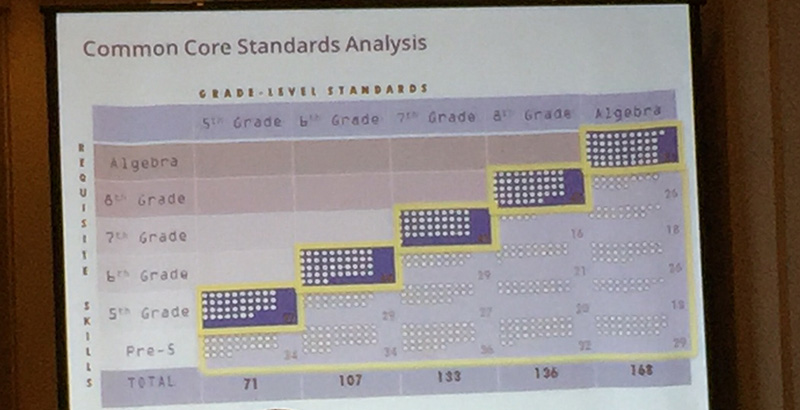When Academic Gaps Spiral Year After Year: The Harrowing ‘Jenga’ of Lost Student Skills — Captured in One Chart

If a picture is worth 1,000 words, then perhaps a PowerPoint slide can be worth 168 missing skills.
During a recent Education Reform Now confab in Washington, D.C., Joel Rose walked attendees through a system for improving math instruction developed by the nonprofit he founded, New Classrooms. Broadly sketched, the program helps teachers reach a classroom crowded with students who have vastly different levels of understanding of both the day’s lesson and the background needed to digest it.
A former fifth-grade teacher, Rose led the creation of School of One, a personalized middle school math program developed by the New York City Department of Education. New Classrooms’ current effort, Teach to One, is an outgrowth of that eight-year-old effort, in which students receive a daily “playlist” of skills they work on with teachers, peers, and online tutorials.
One slide in his deck in particular ought to be “borrowed” liberally and often for its ability to communicate, visually and succinctly, the often vexing abstraction of how struggling students fall further and further behind.
We’ve heard it a thousand times if we’ve heard it once: The academic gap between disadvantaged and affluent kids starts out small in the early years and compounds as a student progresses through school. By the time a young person living in poverty, with a disability, or learning English is in high school, it’s often a yawning chasm.
It’s practically educational dicta. But how many non-teachers understand how that gap opens and what widens it? And how many educators have truly absorbed the drip-drop impact of the small deficits they let go during their daily triage?
Rose started describing the bottom left hand corner of the slide. A purple box labeled “5th grade” represents the 37 math skills students are expected to acquire and master by the end of that school year, and on which they will be tested on state accountability exams.
A lavender box underneath represents the 34 skills those students were expected to master in earlier grades – knowledge they will need to pass the end-of-year assessment of the fifth-grade curriculum. Which of those 34 underlying skills an individual student will have missed and which they’ve mastered can be a potluck proposition for a teacher at the start of the school year.
This presents a dilemma in terms of prioritizing: Keep the class moving on the 37 fifth-grade skills (or “standards,” in edu-jargon) as a group, or go back and figure out each student’s patchwork quilt of understanding? In most classrooms, the former wins out for any number of reasons ranging from “My job is to teach fifth grade, not K-4,” to the basic calculus of a high number of kids and a small number of spare minutes.
As the purple and lavender boxes advance up and to the right, the number of potential missed skills grows exponentially, reaching 168 when a student reaches high school math.
Ninth grade is, of course, pivotal. One F in ninth grade decreases a student’s chances of graduating by 30 percentage points; two F’s, and the chance drops by 50 percentage points, from 85 percent to 33 percent. Fewer than a fourth of students who aren’t on track that year will graduate high school.
Think of it as something akin to Jenga: If too many planks are missing at the base you won’t be able to build very far. Indeed the process of trying to wedge missing-skills planks into wobbly understandings is often referred to as “scaffolding.”
Rose’s Teach to One is one of myriad systems for using technology to help teachers resolve the tension between probing for missing foundational skills and making sure all 37 of fifth grade’s skills get taught. The University of Chicago’s Urban Education Institute has an early-years literacy equivalent, STEP, that has built-in strategies for helping, say, a second-grade teacher back-fill a kindergarten skill.
Two separate studies by Teachers College at Columbia University found that students participating in New York City’s School of One — which became the independent, nonprofit Teach to One in 2011 — gained the equivalent of 1.2 extra years of math knowledge in a single academic year and learned at 1.5 times the pace of their peers.
Yes, we ask today’s teachers to do far more than their predecessors. Good thing we have much more sophisticated tools to offer them.
Help fund stories like this. Donate now!

;)
